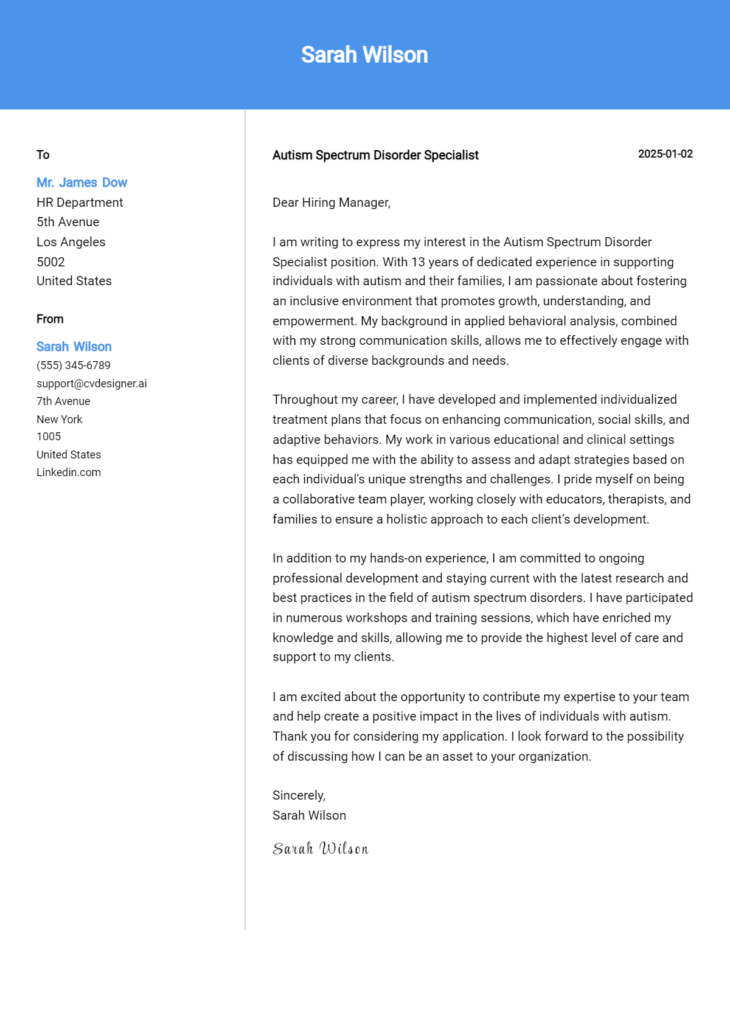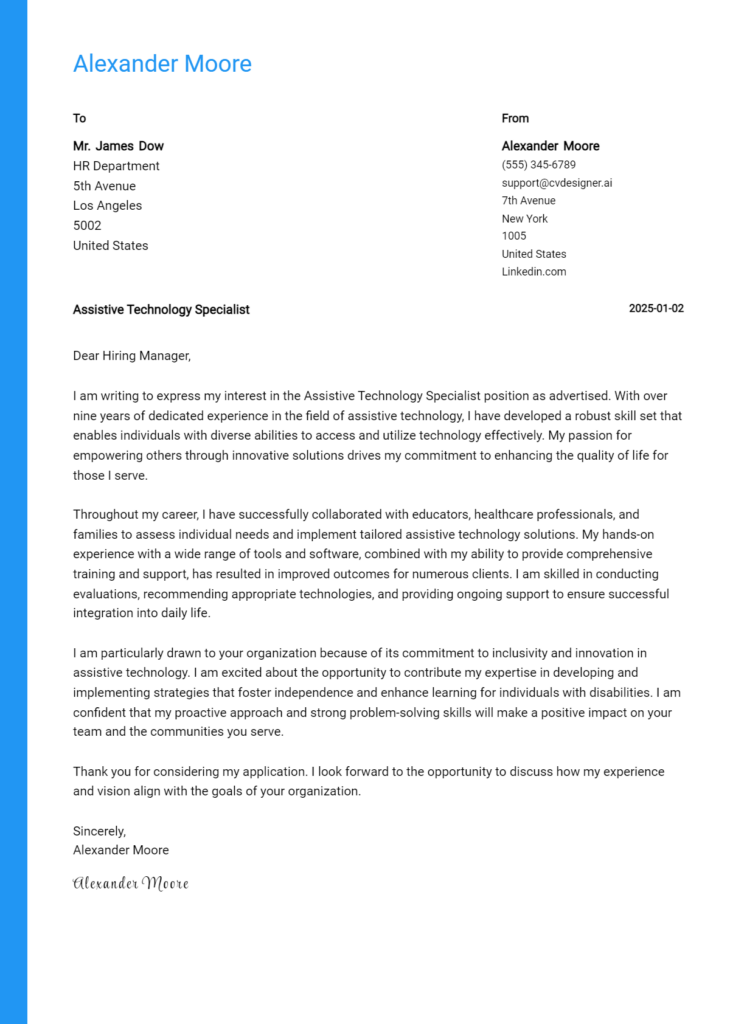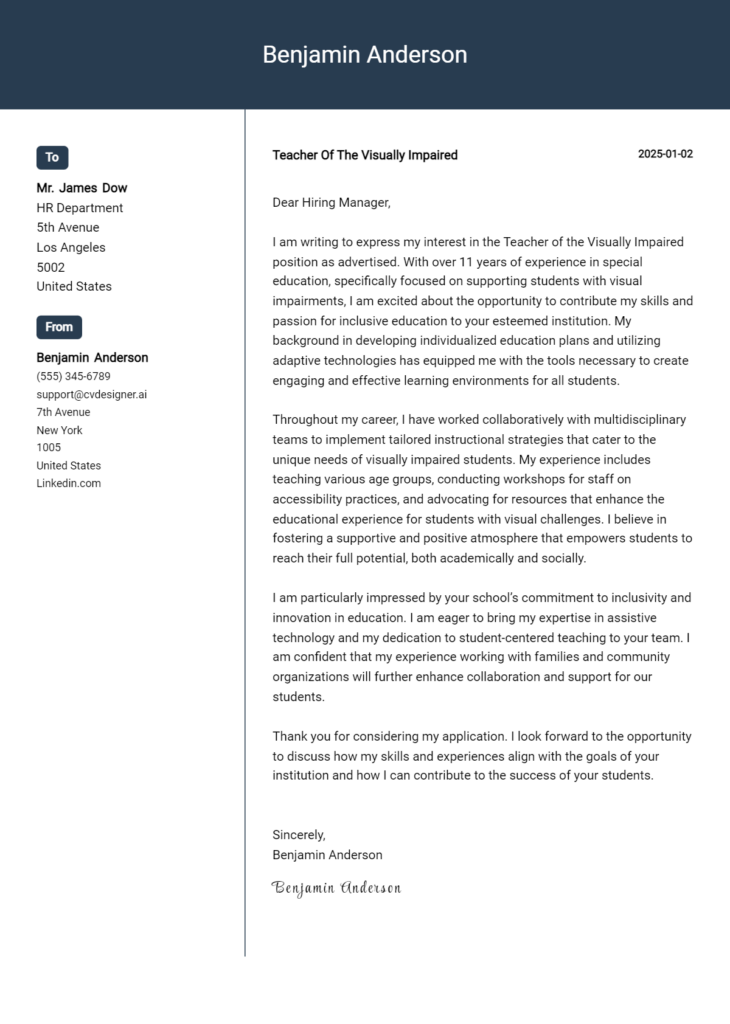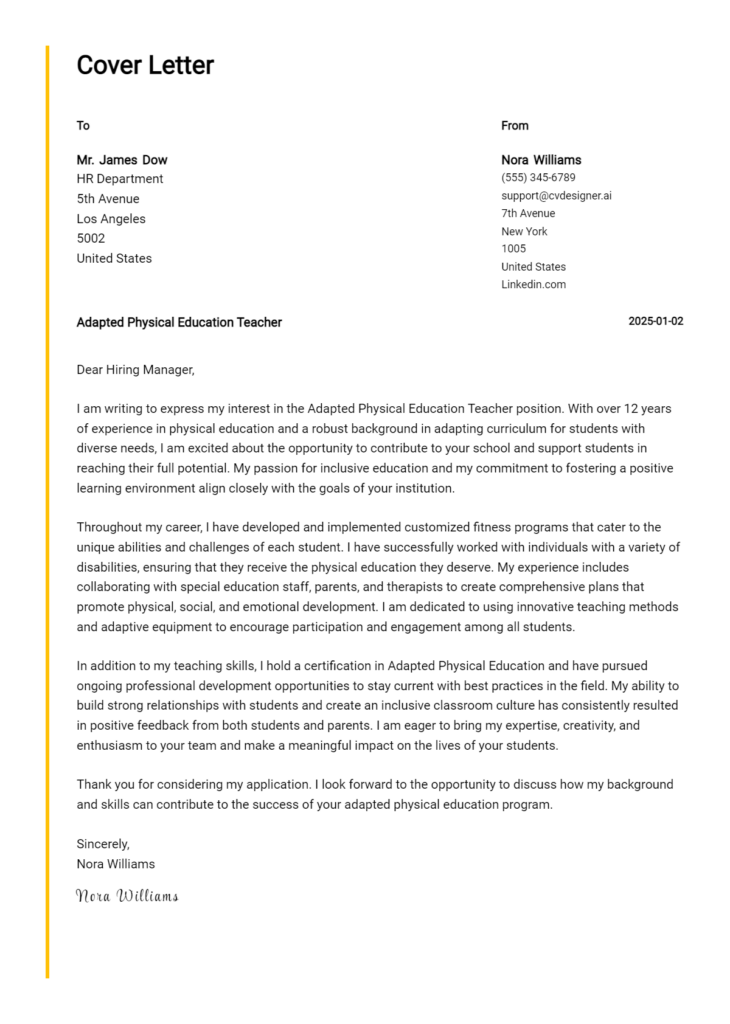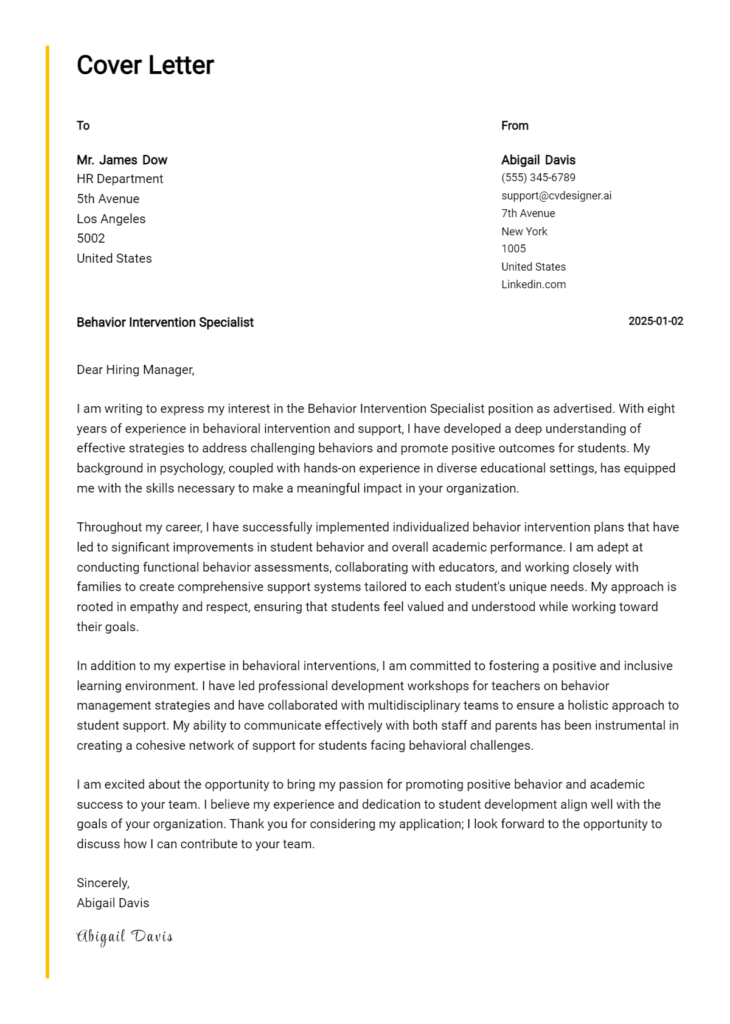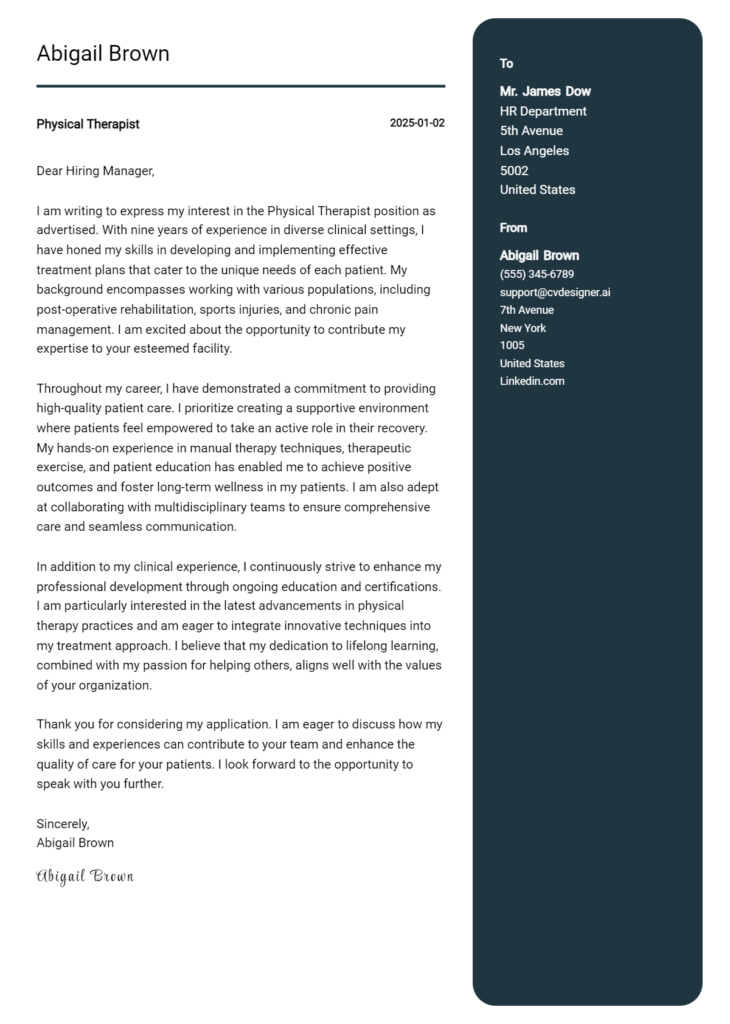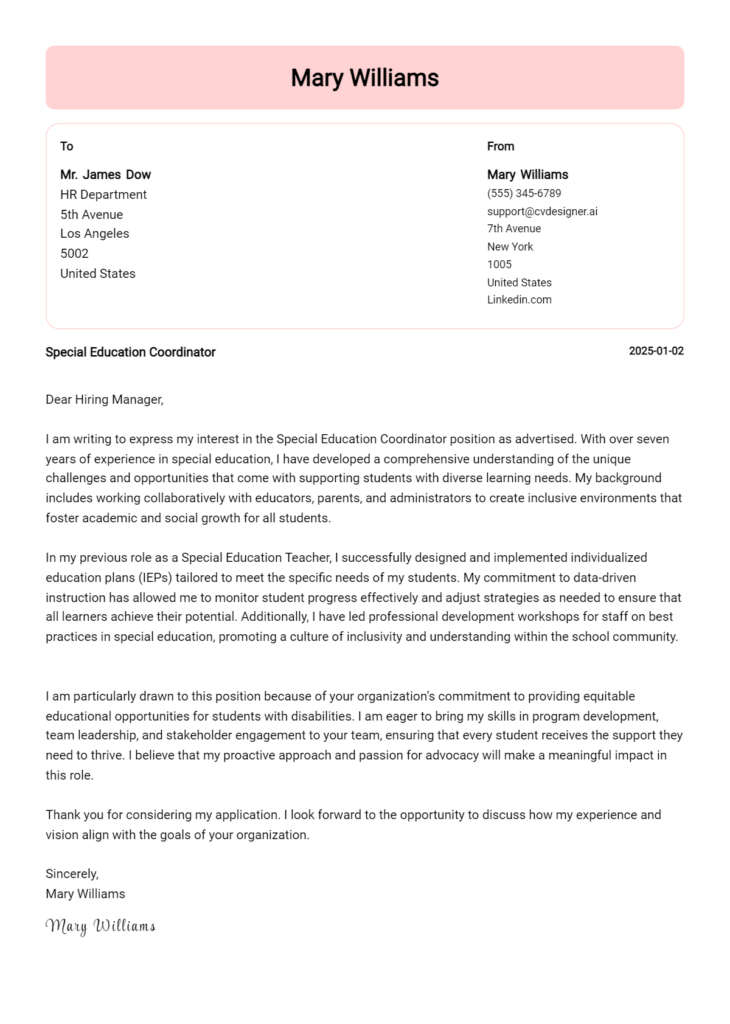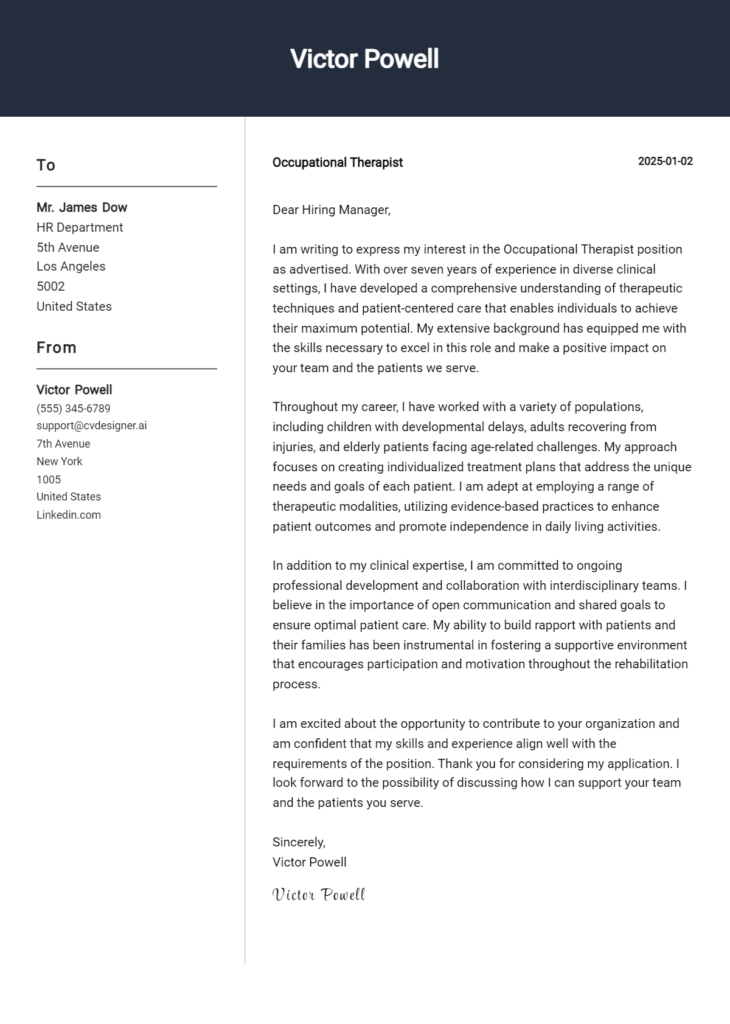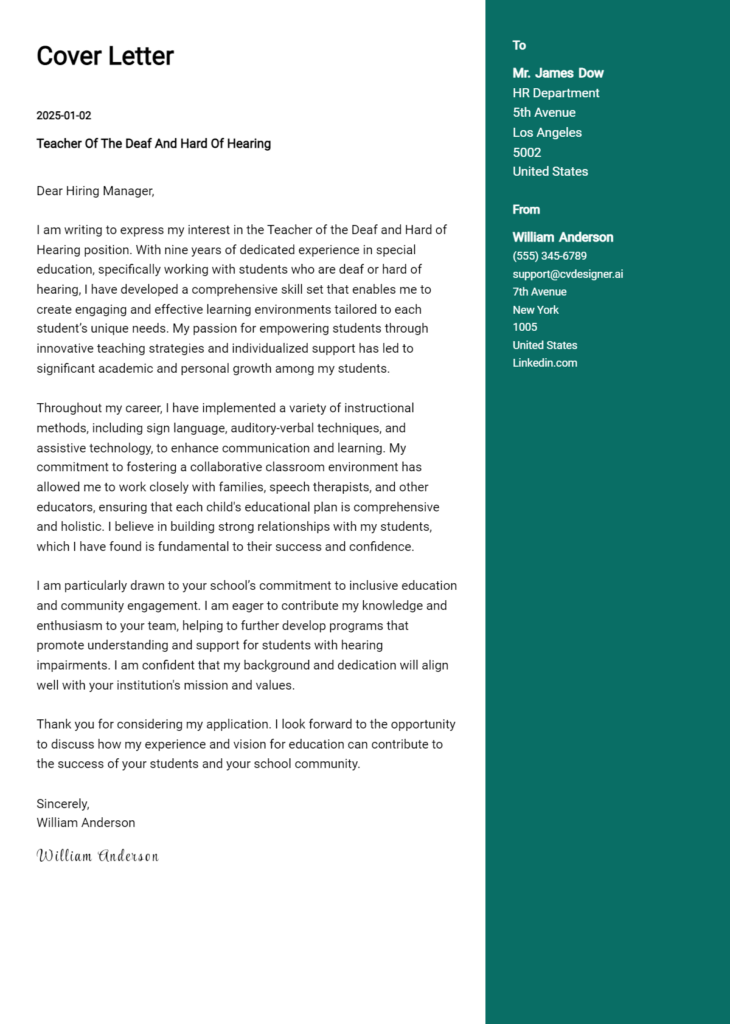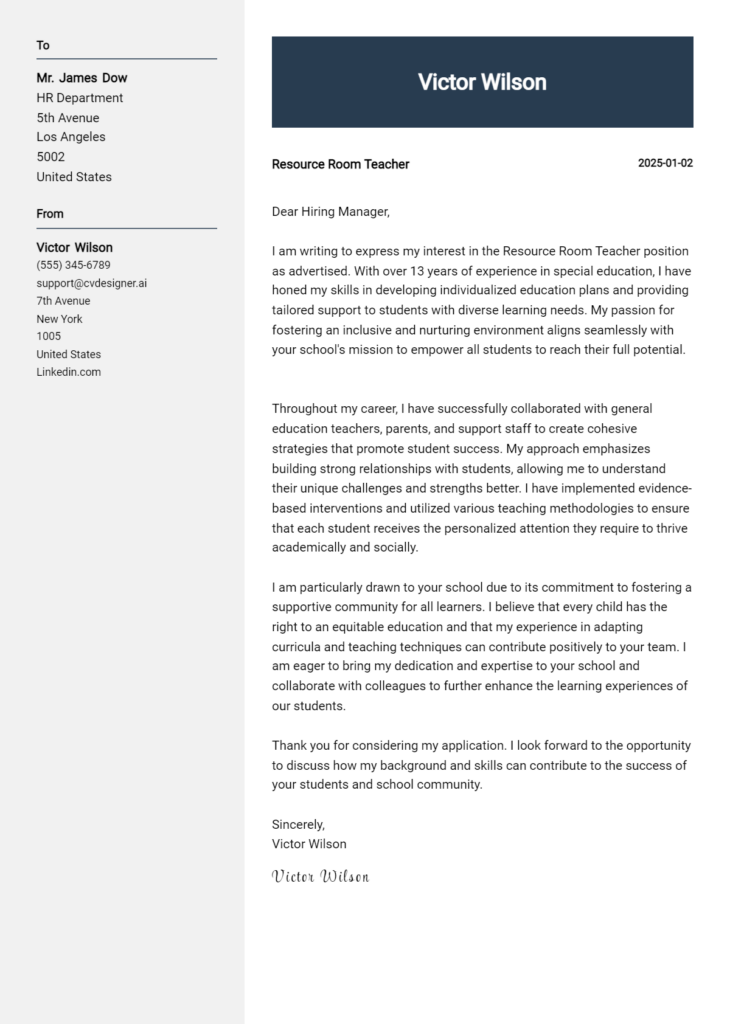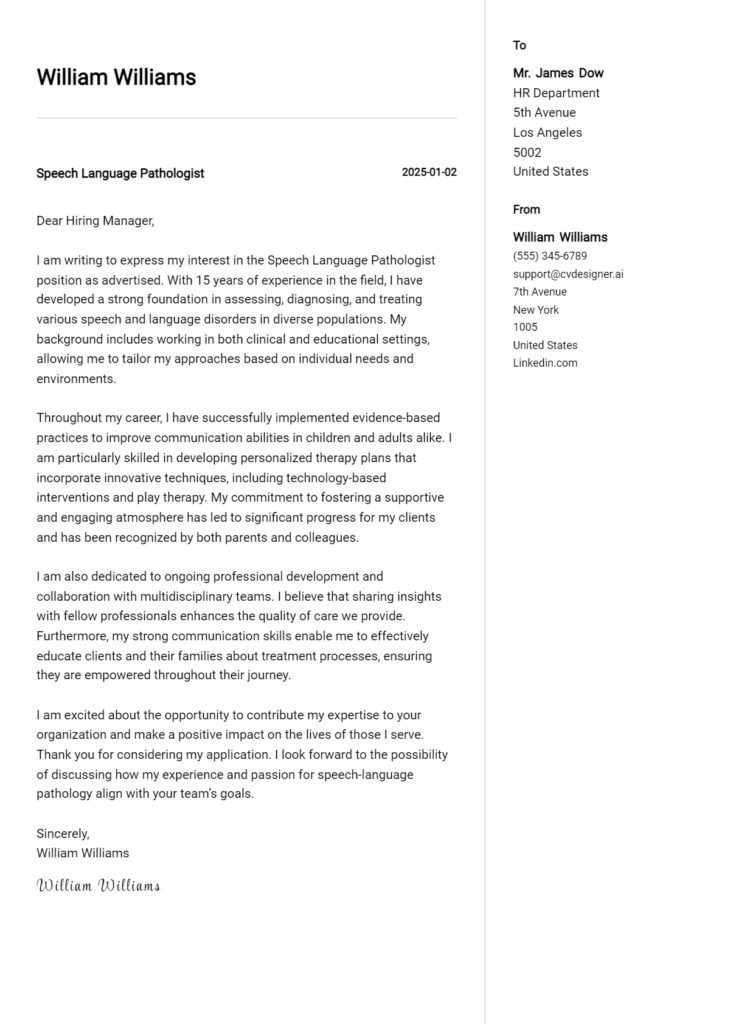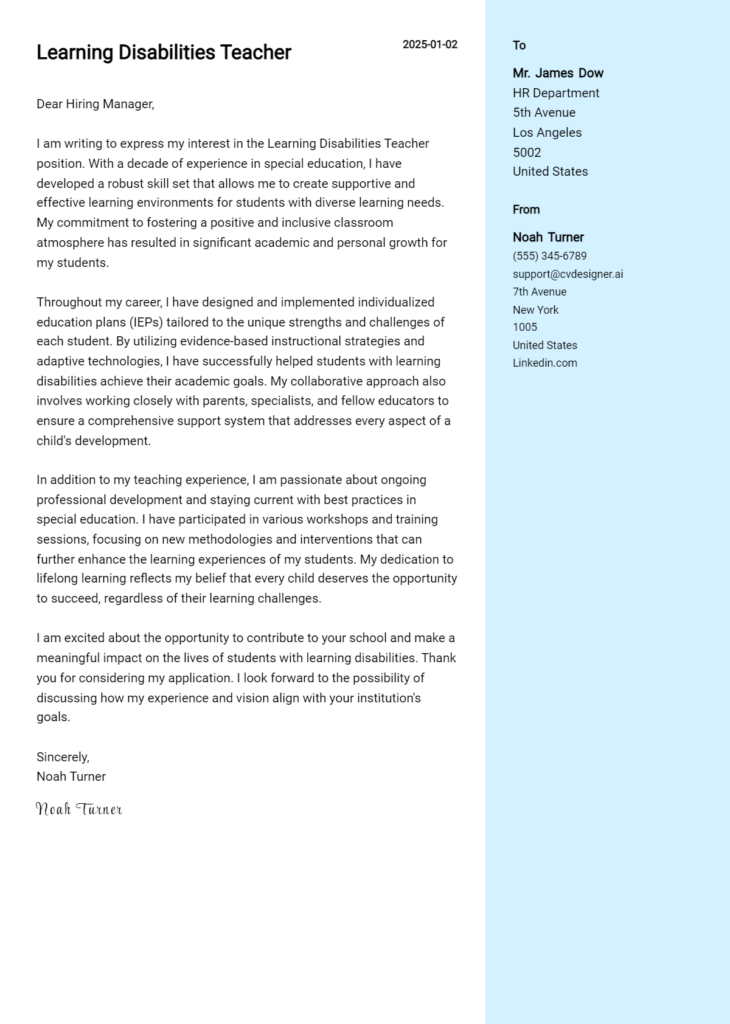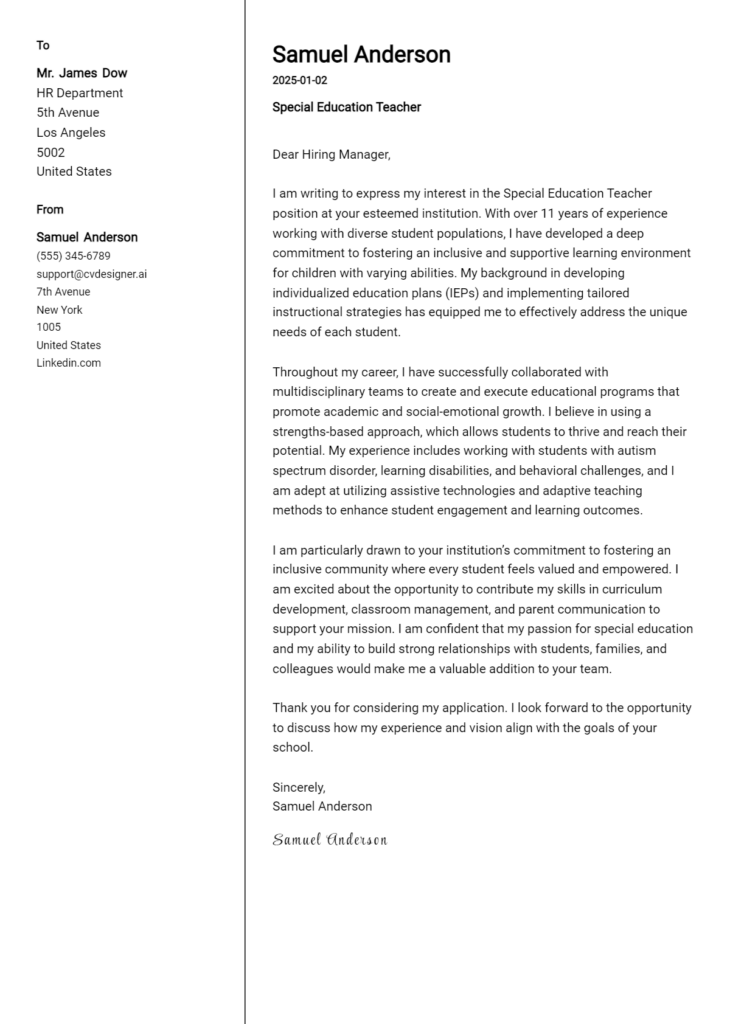Inclusion Specialist Cover Letter Examples
Explore additional Inclusion Specialist cover letter samples and guides and see what works for your level of experience or role.
How to Format an Inclusion Specialist Cover Letter
Crafting a compelling cover letter is essential for an Inclusion Specialist, as it serves as your first opportunity to convey your passion for diversity and inclusion. The way you format your cover letter not only reflects your professionalism but also demonstrates your commitment to creating inclusive environments. A well-structured cover letter can capture the hiring manager's attention and effectively communicate your skills and experiences that align with the role—key qualities for an Inclusion Specialist.
In this guide, we'll outline how to structure your cover letter, providing insights and examples specific to the field of inclusion and diversity.
We'll focus on the essential components of a professional cover letter, including:
- Cover Letter Header
- Cover Letter Greeting
- Cover Letter Introduction
- Cover Letter Body
- Cover Letter Closing
Each section is crucial in showcasing your qualifications and dedication to fostering inclusivity. Let’s break down each part and explore how to make your Inclusion Specialist cover letter truly stand out.
Importance of the Cover Letter Header for an Inclusion Specialist
The cover letter header is a crucial element of any professional application, particularly for an Inclusion Specialist. It serves as the first impression, setting the tone for the rest of the letter. A well-organized header not only provides essential contact information but also conveys clarity and professionalism, which are vital in a role that advocates for inclusion and diversity. The header should include your name, address, phone number, email, the date, and the recipient's name and title, along with their organization's address. This structured presentation ensures that your application is easy to navigate and demonstrates your attention to detail—an important trait for an Inclusion Specialist.
Strong Example
John Doe 123 Inclusion Lane Diversity City, ST 12345 (123) 456-7890 johndoe@email.com October 1, 2023 Ms. Jane Smith Director of Diversity and Inclusion Inclusive Organization 456 Equity Blvd Diversity City, ST 12345
Weak Example
johndoe@email.com October 1, 2023 To Whom It May Concern
The Importance of the Cover Letter Greeting for an Inclusion Specialist
The greeting of a cover letter plays a crucial role in setting the tone for the entire document. It’s the first impression hiring managers will have of you, and a well-crafted greeting can demonstrate your professionalism and commitment to the position. By addressing the hiring manager directly, you show that you have taken the time to personalize your application, which can resonate positively with potential employers. To avoid generic greetings that may come off as impersonal, it’s beneficial to research the recipient’s name if possible. This small effort can help you stand out in a competitive job market.
When crafting your greeting, consider the following tips: use a formal salutation, double-check the spelling of the hiring manager's name, and ensure that the tone matches the company culture. Below are examples of strong and weak greetings for an Inclusion Specialist cover letter to help guide you in making an impactful choice.
Strong Example
Dear Ms. Johnson,
Weak Example
To Whom It May Concern,
The Importance of a Well-Crafted Cover Letter Introduction for an Inclusion Specialist
A well-crafted cover letter introduction is crucial for an Inclusion Specialist, as it serves as the first impression to the hiring manager. This introduction should not only capture attention but also convey genuine interest in the role while briefly highlighting key skills or achievements relevant to promoting inclusivity. A compelling opening sets the tone for the entire letter, making it more likely for the candidate to stand out among a sea of applicants. Below are examples of strong and weak cover letter introductions for the Inclusion Specialist role.
Strong Example
Dear [Hiring Manager's Name], As a passionate advocate for diversity and inclusion with over five years of experience in developing and implementing inclusive programs, I am thrilled to apply for the Inclusion Specialist position at [Company Name]. My work with underrepresented communities has not only honed my ability to create equitable learning environments but also resulted in a 30% increase in participation from marginalized groups in our initiatives. I am excited about the opportunity to bring my expertise and enthusiasm to your team, ensuring that every individual feels valued and supported.
Weak Example
Hi, I saw the job posting for the Inclusion Specialist and thought I would apply. I have some experience in diversity work and have done a few projects, so I think I might be a good fit. I hope to contribute to your team somehow.
Purpose of the Cover Letter Body for an Inclusion Specialist
The body of a cover letter for an Inclusion Specialist plays a crucial role in demonstrating the candidate's qualifications, relevant experiences, and the unique value they bring to the organization. This section allows the applicant to highlight specific projects or accomplishments that showcase their expertise in fostering inclusive environments. By providing clear and compelling examples of past work, such as implementing successful diversity training programs or leading initiatives to improve accessibility, candidates can effectively convey their ability to contribute positively to the company's culture and objectives.
Strong Example
In my previous role at XYZ Corporation, I spearheaded a comprehensive diversity initiative that resulted in a 30% increase in underrepresented groups within our workforce over two years. By collaborating with various stakeholders, I developed training modules that educated staff about unconscious bias, which significantly improved team dynamics and employee satisfaction scores. Additionally, I successfully launched a mentorship program that paired junior employees from diverse backgrounds with senior leaders, enhancing career advancement opportunities and fostering a culture of inclusion. These experiences have equipped me with the skills and insights necessary to drive similar initiatives at your organization, ultimately contributing to a more diverse and equitable workplace.
Weak Example
I have worked in various roles where I dealt with inclusion. In one job, I helped with some training about diversity, but I don't remember the details. I think it's important to have diverse teams because it brings different perspectives. I believe I can help your company with inclusion efforts because I have experience in the field, even if it wasn't very extensive.
Importance of the Cover Letter Closing for an Inclusion Specialist
The closing paragraph of a cover letter is crucial for leaving a lasting impression on the hiring manager. As an Inclusion Specialist, it's important to summarize your qualifications, reiterate your passion for promoting diversity and inclusion, and encourage the next steps in the hiring process, such as reviewing your resume or scheduling an interview. A strong closing can effectively convey your enthusiasm for the role and your readiness to contribute to the organization, while a weak closing may fail to leave a memorable impact.
Strong Example
Thank you for considering my application for the Inclusion Specialist position. I am excited about the opportunity to bring my extensive experience in developing inclusive programs and fostering a diverse environment to your team. I am confident that my background in educational equity and community engagement aligns perfectly with your organization's mission. I look forward to the possibility of discussing how my skills can contribute to your ongoing efforts. Please feel free to review my resume, and I hope to schedule an interview soon.
Weak Example
Thanks for reading my letter. I think I would be okay at the Inclusion Specialist job. You can look at my resume if you want. Let me know if you want to talk.
These tips will help candidates craft an effective cover letter for an Inclusion Specialist position, emphasizing the importance of showcasing technical skills, problem-solving abilities, understanding the Software Development Life Cycle (SDLC), teamwork, and a passion for continuous learning. A well-written cover letter can set you apart in a competitive job market and highlight your commitment to fostering inclusivity in the workplace.
Cover Letter Writing Tips for Inclusion Specialist
Highlight Relevant Technical Skills: Clearly outline your technical proficiencies that relate to inclusion, such as familiarity with accessibility tools, data analysis software, or content management systems. This will demonstrate your capability to implement inclusive practices effectively. Use specific examples that reflect how you’ve utilized these skills in past roles.
Showcase Problem-Solving Abilities: Inclusion specialists often face unique challenges. Include instances where you successfully identified a problem related to inclusion and the steps you took to resolve it. This not only shows your analytical thinking but also your proactive approach to fostering an inclusive environment.
Demonstrate Knowledge of SDLC: Understanding the Software Development Life Cycle is crucial, especially if your role involves working with tech teams. Mention any experience you have with SDLC processes and how you have contributed to projects that prioritize inclusivity throughout the development phases.
Emphasize Teamwork and Collaboration: Inclusion is a team effort. Provide examples of how you have worked collaboratively with diverse groups to promote an inclusive culture. Highlight your ability to communicate effectively and resolve conflicts within a team setting, making it clear that you value and respect diverse perspectives.
Express Passion for Continuous Learning: The field of inclusion is always evolving, and demonstrating an eagerness to learn can set you apart. Mention any relevant certifications, workshops, or courses you’ve completed, and express your commitment to staying updated on best practices for inclusion. This shows that you are not only knowledgeable but also dedicated to personal and professional growth.
For additional resources, consider exploring various cover letter templates or utilizing a cover letter builder to streamline the process of creating a standout cover letter.
Common Mistakes to Avoid in an Inclusion Specialist Cover Letter
Avoiding common mistakes in your cover letter is crucial for making a strong impression as an Inclusion Specialist. A well-crafted cover letter can showcase your passion for inclusivity and demonstrate your qualifications effectively. Here are some common pitfalls to steer clear of:
Generic Greetings: Using "To Whom It May Concern" can make your letter feel impersonal. Instead, research the hiring manager’s name and address them directly.
Lack of Specificity: Failing to mention specific experiences or qualifications can diminish your impact. Tailor your cover letter to include relevant examples from your background that align with the job description.
Neglecting Formatting: An unorganized or cluttered layout can distract from your message. Follow a professional cover letter format to ensure clarity and readability.
Focusing on Responsibilities Instead of Achievements: Many candidates list job duties rather than highlighting their accomplishments. Showcase how your contributions made a difference in previous roles.
Using Buzzwords Without Context: Overusing jargon can come off as insincere. Instead, explain your skills and experiences with specific examples that illustrate your commitment to inclusion.
Ignoring the Company’s Values: Not aligning your letter with the organization’s mission can weaken your application. Research the company’s values and integrate them into your narrative.
Spelling and Grammatical Errors: Typos can undermine your professionalism. Always proofread your cover letter carefully or ask someone else to review it.
For inspiration, check out some effective cover letter examples to help guide your writing process.
Cover Letter FAQs for Inclusion Specialist
What should I include in my cover letter for an Inclusion Specialist position?
When crafting your cover letter for an Inclusion Specialist role, focus on your relevant experiences and skills that demonstrate your commitment to diversity and inclusion. Start with a strong opening that highlights your passion for inclusive practices. Include specific examples of past work, such as developing programs or initiatives that promoted equity. Mention any collaborations with diverse communities, and outline how you assess and address barriers to inclusion. It's essential to convey your understanding of relevant laws, regulations, and best practices in the field. Finally, express your enthusiasm for the position and how your background aligns with the organization's mission.
How do I tailor my cover letter for a specific Inclusion Specialist job?
To tailor your cover letter for a specific Inclusion Specialist job, research the organization thoroughly. Identify its values, mission, and current initiatives related to inclusion and diversity. Use this information to demonstrate your alignment with their goals. Highlight experiences and skills that directly relate to the job description, emphasizing measurable outcomes from past initiatives you've led. Use keywords from the job posting to reinforce your fit for the role. Personalizing your letter not only shows your interest but also illustrates how your unique background can contribute to their specific needs.
Should I include my educational background in my cover letter?
Yes, including your educational background in your cover letter is important, especially if it relates to the field of inclusion and diversity. Mention your degree(s), any relevant certifications, and specialized training that showcase your expertise. If you have completed projects or coursework pertinent to inclusion practices, briefly describe them to demonstrate your knowledge in the area. However, keep the educational details concise; your cover letter should primarily focus on your practical experiences and achievements. The goal is to show how your education complements your real-world application of inclusive practices.
How can I demonstrate my commitment to diversity and inclusion in my cover letter?
To effectively demonstrate your commitment to diversity and inclusion in your cover letter, share specific examples of initiatives or projects you've worked on that advanced these values. Discuss any roles where you advocated for underrepresented groups or implemented strategies that fostered a more inclusive environment. Highlight any training or workshops you’ve attended that enhanced your understanding of diversity issues. Additionally, express your personal philosophy towards inclusion and why it matters to you on a professional and personal level. This not only shows your dedication but also helps potential employers understand your motivation and alignment with their own inclusivity goals.
Build your Cover Letter in minutes
Use an AI-powered cover letter builder and have your letter done in 5 minutes. Just select your template and our software will guide you through the process.


